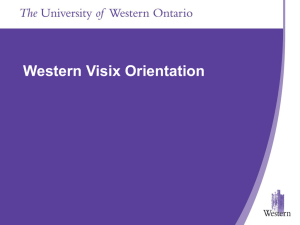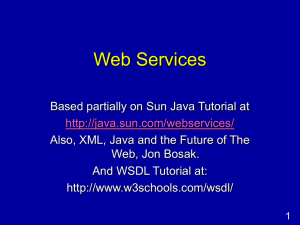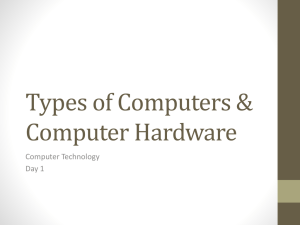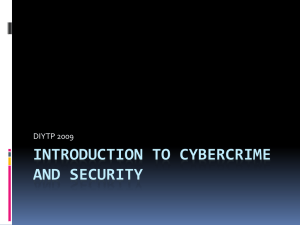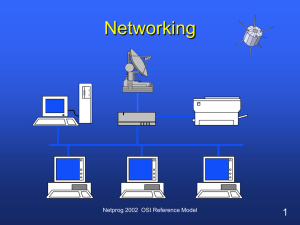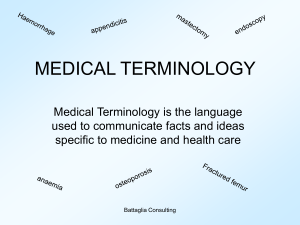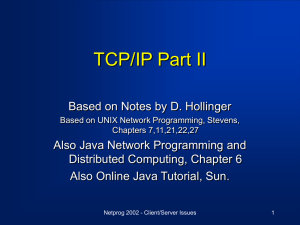PPT
advertisement
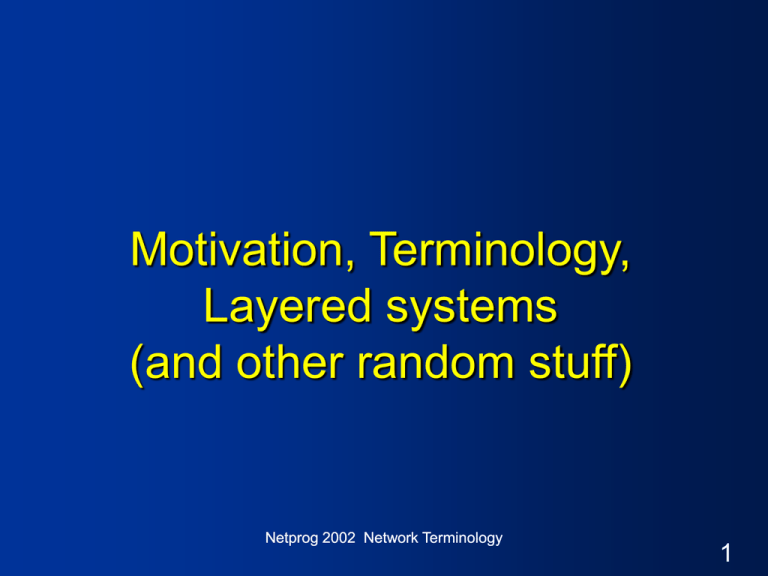
Motivation, Terminology, Layered systems (and other random stuff) Netprog 2002 Network Terminology 1 History and Motivation First stored-program computer: 1949 ARPANet 56Kbps: 1970 TCP/IP: 1972 IBM Personal Computer: 1981 Local Area Networks: 1982 World-Wide Web: 1989 Java: 1995 Netprog 2002 Network Terminology 2 History and Motivation Early computers were highly centralized. – Single point of failure – User has to “go to” the computer. Proliferation of low cost computers made it possible to get past these 2 primary disadvantages (with a network). Netprog 2002 Network Terminology 3 Motivation Sharing of resources is more efficient Price/Performance Use each piece of equipment for what it is best at Centralize administration Computers as communication tools Netprog 2002 Network Terminology 4 Rates of Growth Moore’s Law – “Number of transistors in chips doubles every 18 months”. – Every 10 years, processors are 100 times more powerful. Gilder’s Law – “Bandwidth grows at least three times faster than computer power”. – Assuming bandwidth doubles every 12 months; every 10 years, it is 1000 times better. Netprog 2002 Network Terminology 5 Computer Networks are now everywhere PCs <-> Mainframes Automated Tellers Embedded Systems Communications Systems The Internet Netprog 2002 Network Terminology 6 Networked Computers Traditional Uses Communication (email) File exchange, disk sharing Sharing peripherals (printers, tape drives) Remote execution Netprog 2002 Network Terminology 7 New(er) Uses for Networked Computers Entertainment, distributed games – MP3s! Commerce – Automation of business processes Collaborative computing – Homework Submission Worldwide Computing Netprog 2002 Network Terminology 8 Wide variety of types of networks circuit switched – telephone system packet switched: – The Internet (TCP/IP) Netprog 2002 Network Terminology 9 Network Models Using a formal model allows us to deal with various aspects of Networks abstractly. We will look at a popular model (OSI reference model). The OSI reference model is a layered model. Netprog 2002 Network Terminology 10 Layering Divide a task into pieces and then solve each piece independently (or nearly so). Establishing a well defined interface between layers makes porting easier. Major Advantages: Code Reuse Extensibility Netprog 2002 Network Terminology 11 Layering Example: Federal Express Letter in envelope, address on outside FedX guy adds addressing information, barcode. Local office drives to airport and delivers to hub. Sent via airplane to nearest city. Delivered to right office Delivered to right person Netprog 2002 Network Terminology 12 FedX Layers Letter Addressed Envelope Letter Addressed Envelope Netprog 2002 Network Terminology 13 Layered Software Systems Network software Operating systems Windowing systems Netprog 2002 Network Terminology 14 Unix is a Layered System Applications Libraries System Calls Kernel Netprog 2002 Network Terminology 15 OSI Reference Model The International Standards Organization (ISO) proposal for the standardization of the various protocols used in computer networks (specifically those networks used to connect open systems) is called the Open Systems Interconnection Reference Model (1984), or simply the OSI model. Netprog 2002 Network Terminology 16 OSI Model Although the OSI model is a just a model (not a specification), it is generally regarded as the most complete model (as well it should be - nearly all of the popular network protocol suites in use today were developed before the OSI model was defined). Netprog 2002 Network Terminology 17 OSI <-> Network Software Although this course is about network programming (and not about networking in general), an understanding of a complete network model is essential. We will look at the OSI Reference Model in detail. Netprog 2002 Network Terminology 18 OSI 7 Layer Model: 7 6 5 4 3 2 1 Application Presentation Session Transport Network Data-Link Physical High level protocols Low level protocols Netprog 2002 Network Terminology 19 Simplified Network Model Process Process Interface Protocols Transport Transport Peer-to-peer Protocols Network Network Data Link Data Link Netprog 2002 Network Terminology 20 What’s a Protocol? An agreed upon convention for communication. – both endpoints need to understand the protocol. Protocols must be formally defined and unambiguous! We will study lots of existing protocols and perhaps develop a few of our own. Netprog 2002 Network Terminology 21 Process Process Interface Protocols Transport Transport Peer-to-peer Protocols Network Network Data Link Data Link Interface and Peer-to-peer Protocols Interface protocols describe the communication between layers on the same endpoint. Peer-to-peer protocols describe communication between peers at the same layer. Netprog 2002 Network Terminology 22 Thought Exercise Come up with an example of a layered system. Describe the interface and peer-to-peer protocols for your example. Netprog 2002 Network Terminology 23 Programs & Processes A program is an executable file. A process or task is an instance of a program that is being executed. A thread is a light-weight process. A single program can generate multiple processes or contain multiple threads. Netprog 2002 Network Terminology 24 Client - Server A server is a process - not a machine ! A server waits for a request from a client. A client is a process that sends a request to an existing server and (usually) waits for a reply. Netprog 2002 Network Terminology 25 Client - Server Examples Server returns the time-of-day. Server returns a document. Server prints a file for client. Server does a disk read or write. Server records a transaction. Netprog 2002 Network Terminology 26 Servers Servers are generally more complex (more interesting). 2 Basic types of servers: Iterative - server handles one client at a time. Concurrent - server handles many clients at a time. We will study the differences later. Netprog 2002 Network Terminology 27 Peer-to-peer Computing Clients are also servers, a.k.a. servents. Decentralized control. E.g., Gnutella, Freenet. Netprog 2002 Network Terminology 28 Java and Multithreading In Java, it is possible to create multithreaded programs. The java.lang package contains a Thread class. The java.lang.Object class contains internal locks for thread synchronization. Netprog 2002 Network Terminology 29
